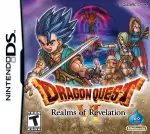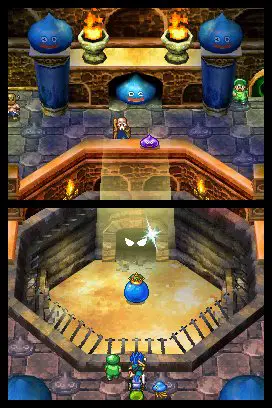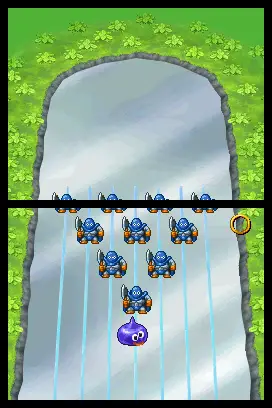Another feature that will be somewhat familiar to those who played previous Dragon Quest games is the ability to recruit monsters. However, in this DS version, you can only recruit slimes (with one exception), and you don’t need a special job class in order to do so. However, most slimes will not join you unless you’ve met certain qualifications first, some of which can be a bit annoying, especially since several of these slimes aren’t terribly useful as party members. What disappointed me the most about this system is that about half of the recruitable slimes cannot be recruited at all until after you’ve finished the game. With only one bonus dungeon, it basically means that most won’t bother unless you’re just an obsessive completionist. For example, several of the slimes only become available after you’ve tagged ten other players – something that might be easily done in an hour or less in population-dense, Dragon Quest-crazy Japan, but that is almost impossible for most US players. Not to mention the fact that the added tag mode (one of the only additions to this remake) is pretty stupid. You basically collect “dreamscapes” you find around the world (which are basically backdrops, and which you can’t even see until you create one for tag mode), create an avatar, and that’s about it. I honestly think the game would have been better without it, but maybe that’s just me being bitter.
You will find a couple of the recruited slimes come in handy, particularly Healie, a heal slime that has the best healing spells in the game, and whom you will probably keep in your adjunct party for most of the game once you recruit him. You may also find yourself leveling up some of the other slimes so they can compete in slime battles in the arena. About midway through the game, you will discover the slime arena, where slimes fight for prizes. There are different levels, based on how strong your slime is, and each level has its own prize if your slime wins. The catch is that you have to pay in order to fight, and if you loose, you loose your money as well. You also can’t control your slime at all during these battles, so you have to hope you have him well equipped and leveled up enough to survive. These create a fun diversion from the main game, and although none of the prizes are necessary in order to beat the game, a few of them do come in handy.
The other major diversion in the game is the fashion show. I thought this was an interesting and different concept, but it was a bit tedious. Basically, every person (or slime) in your party has innate style points, and each piece of weapon or armor does as well (you can even spend money to have some of these items forged to increase their style). Wearing items in certain combinations can also give you bonus points. Like the slime arena, the fashion show has various levels from beginner to fashionista, and the game requires you to win up to the third round (eight is the highest) in order to proceed, because, like the slime battles, you get a unique prize each time you win (although you don’t have to pay to enter). While I appreciate something different, these shows are tedious to go through (and repetitive), and it can be frustrating trying to win (especially toward the end), as the style scores seem to be outrageous (and definitely higher than they were in the original game). It’s also frustrating that the style points serve no other purpose than for this diversion, and, when you realize how you basically only needed the special item for a very short period of time, it makes you wonder why it had even been included in the first place.
One final diversion, and one I didn’t enjoy (but others might), is a slime curling minigame you can find in several of the towns you visit. Basically, you use the stylus to help guide a slime down an icy path, avoiding obstacles and so forth, trying to hit the target for points. This (along with the tag mode mentioned previously), are the only additions to the DS remake. While some may find this minigame enjoyable, it’s a bit disappointing that Square couldn’t have bothered to do something a little more than just polish up the graphics for this remake. Even the music, while familiar, is nothing particularly special, and can get a bit redundant by the time you enter the final hours of the game.
You will find plenty of gameplay here: without bothering for the bonus dungeon, I basically clocked just under 57 hours, although you possibly could complete the game in as little as 45 perhaps, if you ignored some of the diversions. Still, grinding extends the playtime significantly; it felt, especially toward the end, like a 35 hour game that had been stretched out ten or twenty hours beyond that, and that is never fun. And, although Dragon Quest as a franchise isn’t known for its epic storylines, you will probably find that other than the interesting parallel world concept, the story in Realms of Revelation is one of the thinnest and uninspired of any in the series.
Perhaps if DQVI had been released before DQIX (as it was in Japan), or if it had been re-imagined in this post-DQIX world (for example: more character customization, better implemented tag mode, side quests, etc.), it’s possible it may have been even better than the phenomenal Dragon Quest IX. However, as it stands, Realms of Revelation is far from my favorite of the series. If you’ve never played a Dragon Quest game before, I’d definitely say start with IX; if you’ve played IX and are looking for something else, I’d recommend IV or V first, as both of those are excellent, and a bit better balanced than VI. All the same, I am grateful that English-speakers can finally play this installment in the franchise, and I’m hopeful that someday we might even see remakes of DQ I, II, III, and VII.
|
Dragon Quest VI: Realms of Revelation
|
||
|---|---|---|
 |
Platform: Nintendo DS Genre: RPG Release Date: 02/14/11 Developer: ArtePiazza Publisher: Nintendo (for Square Enix) ESRB Rating: T for Teen MSRP: $34.99 |
|





